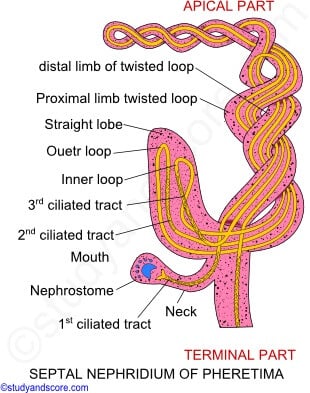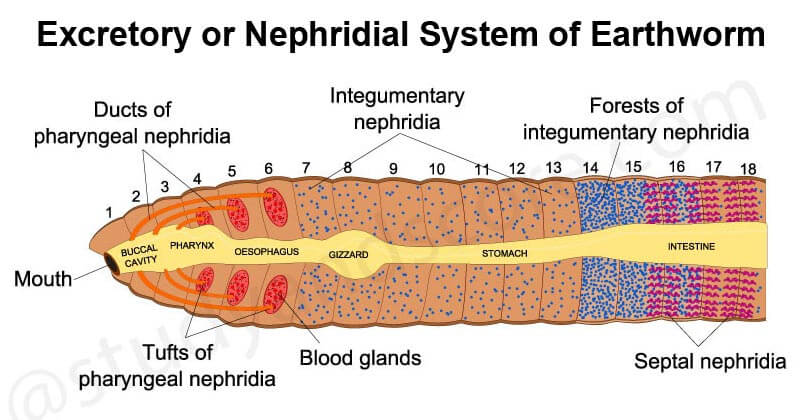The excretory organs are segmentally arranged, microscopic, coiled tubules called nephridia. Nephridia are ectodermal in origin. These are typically unbranched, and their inner ends open into coelom by a ciliated funnel, called nephrostome. A large number of small-sized nephridia are found in each segment which are called micronephridia and mesonephridia. Nephridia occur in all segments of the body except for the first three.
According to their locomotion in the body, they are of 3 types: 1. Septal nephridia, 2. Integumentary nephridia and 3. Pharyngeal nephridia
A. Septal nephridia
- Largest nephridia of Pheretima.
- Found situated on the intersegmental septum between 15th and 16th segments to the posterior side of the body.
- Each septum bears nephridia on both the surfaces arranged in semicircles around the intestine, two rows in front of the septum, and two behind it.
- 40 to 50 nephridia are present in each septum in front and the same number behind so that each segment has 80 to 100 septal nephridia except the 15th segment.
- The 15th segment has only 40 to 50 nephridia.

Figure: Septal nephridium of Earthworm. Image Source: Study and Score.
Interesting Science Videos
Structures
A typical septal nephridium consists of a) nephrostome, b) neck c) body of nephridium, and d) terminal duct.
1. Nephrostome
- Known as a ciliated funnel or nephridiostome.
- Proximal funnel-shaped structure of the nephridium lying in the coelom.
- It consists of an elliptical pore bounded by the so-called upper and lower lips.
- The upper lip is formed of a large central cell and 8 or 9 marginal cells.
- The lower lip is formed of 4 to 5 compact cells.
- All the cells are ciliated.
2. Neck
- The nephrostome leads into a short and narrow ciliated canal forming the neck.
- It joins the nephrostome to the body of nephridium.
3. Body of nephridium
- Consists of 2 parts, a short straight lobe and a long-twisted loop with a narrow apical part.
- Straight lobe length is one half of the twisted loop.
- The twisted loop is formed by 2 limbs – the proximal and distal limb.
- Both limbs are twisted spirally around each other, the number of twists varies from 9 to 13.
- The neck of the nephridium and terminal duct join together and remain connected with the proximal limb of the twisted loop.
- While distal limb becomes straight lobe.
- Internally nephridium is made of connective tissue matrix having long coiled nephridial duct forming loops.
- There are 4 parallel tubules in the straight lobe, 3 in the basal part and 2 in the apical part of each limb of the twisted loop, and a single tubule in each of the neck and terminal duct.
- 2 canals of the straight lobe out of 4 are ciliated line ciliated canal of the neck.
4. Terminal duct
- The distal limb of the body of nephridium ends in a short and narrow duct, called the terminal duct.
- It joins the nephridium with the septal excretory canal.
Arrangement
- The nephridia hang freely in the coelom and are attached only by their terminal ducts.
- Each septum, behind the 15th segment, bears 4 rows of septal nephridia, 2 on the anterior face, and 2 on the posterior face.
- Each row may contain 20 to 25 nephridia so that there are 80 to 100 nephridia on each septum or in each coelomic compartments.
- Nephridia open by their terminal ducts into two septal excretory canals lying on the posterior surface of the septum, one on each side of the intestine.
- These canals discharge their content dorsally into a pair of supra-intestinal excretory ducts of its own side.
- The supra- intestinal excretory ducts are 2 parallel longitudinal canals lying above the gut and below the dorsal vessel.
- These ducts begin from the 15th segment and run to the last segments.
- These ducts open into the intestine in each segment through narrow ductules, each having a sphincter opening.
- The waste collected by the nephridia is discharged through the excretory canals and ducts into the lumen of the intestine.
- Such nephridia opening into the intestine are called enteronephric nephridia.

Figure: Excretory or Nephridial System of Earthworm. Image Source: Study and Score.
B. Integumentary nephridia
- These nephridia are found in the entire inner or parietal surface of the body wall in each segment, except for the first two.
- There are about 200-250 nephridia in each segment except the segment of the clitellar region, where their number increases 2000 consisting of the forests of nephridia.
- They are microscopic V-like in shape and lack nephrostome and without opening into the coelom. Hence, they are called a closed type of nephridia.
- Each nephridium opens by a nephridiopore on the outer surface of the body wall directly.
- Integumentary nephridia discharge the excretory wastes directly outside, hence, they are called exonephric nephridia.
Read Also: Nervous System of Earthworm
C. Pharyngeal nephridia
- Occurs as paired tufts on either side of pharynx and esophagus in the 4th, 5th, and 6th segments.
- The tufts of pharyngeal nephridia also contain blood glands.
- Each nephridium is bout the size of a septal nephridium but is of the closed type having no funnel or nephrostome.
- It has a short straight lobe and a spirally twisted loop; its lumen has ciliated canals.
- In each tuft, the terminal ducts of all tubules join to form a single thick-walled common duct.
- Thus, there are 3 pairs of common pharyngeal nephridial ducts, which run anteriorly parallel to the ventral nerve cord.
- Ducts of the 6th segment open into the buccal cavity, while those of the 4th and 5th open into the pharynx.
- The nephridia also discharge their wastes into the alimentary canal and are, enteronephric.
- But such enteronephric nephridia which opens into the anterior region of the alimentary canal (buccal cavity and pharynx) are called peptonephridia.
- Recently it has been reported that pharyngeal nephridia produce a variety of enzymes like amylase, chymosin, prolinase, prolidase, dipeptides, aminopeptidase, etc. which hydrolyze foodstuffs.
- Thus, such nephridia work like salivary glands.
Video: Excretory system, Types of nephridia & Structure in Earthworm. Video By: Studio Biology

Physiology of excretion
- Like other animals, in earthworms also, protein catabolism results in the formation of nitrogenous waste substances like certain amino acids, ammonia and urea.
- In earthworms, uric acid is not found.
- However, amino acids are degraded to form free ammonia and the urea is synthesized in the chloragogen cells.
- They are released into coelomic fluid and also in blood for its removal.
- Free amino acids are not excreted but traces of creatinine occur in the urine.
- Nitrogen excreted in different forms in the well-fed worm is about 72%NH3, 5% urea, and remaining other compounds.
- While in starved worm NH3 8.6%, urea 84.5%, and remaining being other compounds.
- But generally, the excretion is 42% NH3, 50% urea, 0.6% amino acids, and remaining other compounds.
- NH3 predominates the nitrogenous excretory wastes, hence, it is ammonotelic, in the well-fed worm, while starved one is ureotelic.
- An earthworm excretes the nitrogenous wastes in form of urine which generally contains urea, water, traces of ammonia, and creatinine.
- Nephridia are abundantly supplied with blood vessels.
- Their glands extract excess water and nitrogenous wastes from the blood.
- Septal nephridia also eliminate excretory materials from the coelomic fluid.
- Integumentary nephridia, being exonephric, discharge excretory materials to the outer surface of the body through nephridiopores.
- Pharyngeal and septal nephridia, being endonephric, discharge them into the gut lumen from where they are eliminated through feces.
- The nephridia, in addition to excretory, are also, osmoregulatory in function.
- The nephridia help in conserving water by reabsorption from the excreted product during summers and winters, so they pass hypertonic urine in relation to blood.
- During the rainy season, the urine id dilutes due to lesser reabsorption of water.
- The enteronephric nature of nephridia provides another device for conserving water.
References and Source
- Kotpal RL. 2017. Modern Text Book of Zoology- Invertebrates. 11th Edition. Rastogi Publications.
- Jordan EL and Verma PS. 2018. Invertebrate Zoology. 14th Edition. S Chand Publishing.
- 29% – https://zoologynetwork.blogspot.com/2018/02/excretory-system-of-nephridia.html
- 9% – https://www.biologydiscussion.com/invertebrate-zoology/earthworms/excretory-system-of-nephridia-earthworm/29354
- 3% – https://microbiologynotes.com/excretory-system-of-earthworm/
- 2% – https://ursadhip.blogspot.com/2011/09/nephridia-in-annelida.html
- 1% – https://zoologynetwork.blogspot.com/2018/02/
- 1% – https://www.biologydiscussion.com/invertebrate-zoology/annelida/annelida-history-characters-and-classification-invertebrate-zoology/27978
- <1% – https://www.cliffsnotes.com/study-guides/biology/biochemistry-ii/nitrogen-fixation-assimilation-elimination/urea
- <1% – https://edurev.in/studytube/Earthworm–Chapter-Notes–Class-11–Biology/cbe09ba4-7661-4d5c-8083-b4ac8fcfa960_t
- <1% – https://biologyaipmt.files.wordpress.com/2018/09/ch-7-structural-organisation-of-animals.pdf
